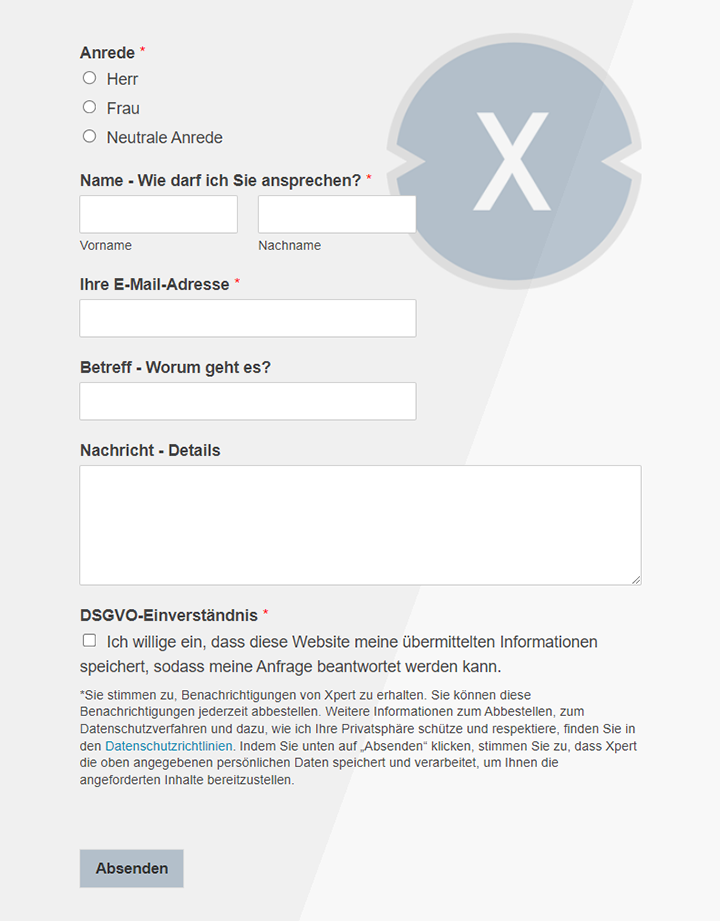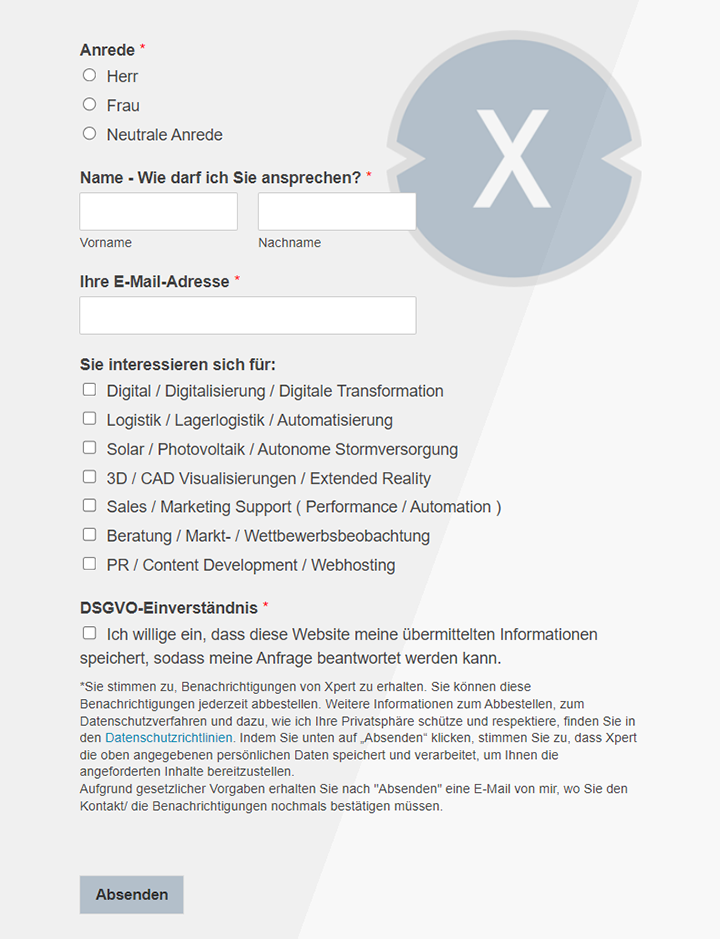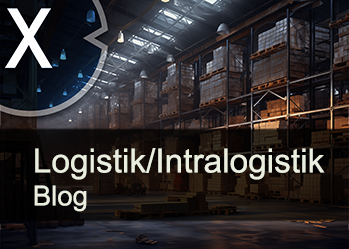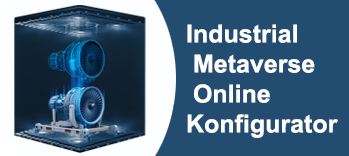The Future of Contract Logistics: Big Changes Through New Technology and the Often Overlooked GS1 DataMatrix Code
Xpert pre-release
Language selection 📢
Published on: December 29, 2024 / update from: December 29, 2024 - Author: Konrad Wolfenstein

The Future of Contract Logistics: Major Changes Through New Technology and the Often Overlooked GS1 DataMatrix Code – Image: Xpert.Digital
Hidden game changer - the 2D matrix code: Why the GS1 DataMatrix code is shaping the future of logistics
Contract logistics, a crucial pillar of the modern economy, is on the threshold of a profound transformation. Driven by a wave of breakthrough technologies, this sector is experiencing a dynamic that takes efficiency, transparency and flexibility to new levels. While terms like artificial intelligence, the Internet of Things and blockchain are on everyone's lips, there is a technology in the background that is often underestimated but has the potential to permanently change the entire landscape: the GS1 DataMatrix code.
Suitable for:
The driving forces of change: An overview of the key technologies
Several innovative technologies are currently shaping the contours of tomorrow's contract logistics:
1. Artificial Intelligence and Machine Learning: The Intelligence of the Supply Chain
Artificial intelligence (AI) and machine learning (ML) are no longer a vision of the future, but rather integral components of advanced logistics strategies. Their ability to analyze enormous amounts of data and derive precise predictions is revolutionizing the way supply chains are planned, controlled and optimized. For example, AI-supported systems enable:
Highly accurate demand forecasts
By analyzing historical sales data, seasonal fluctuations, economic indicators, and even external factors like weather forecasts, AI algorithms can predict future demand with remarkable accuracy. This leads to reduced storage costs, minimized stock-outs and improved customer satisfaction.
Dynamic route planning and transport optimization
AI systems can take into account real-time traffic data, weather conditions, vehicle utilization and delivery time windows to calculate the most efficient routes and reduce transportation costs. They also enable dynamic adjustment of routes in the event of unforeseen events such as traffic jams or road closures.
Automated decision making in real time
In complex logistics networks where decisions must be made quickly, AI systems can optimize operational processes by, for example, optimally allocating orders to available resources or prioritizing deliveries based on urgency and costs.
Intelligent inventory management
AI-powered systems monitor inventory levels in real time, identify trends and patterns, and provide recommendations for optimal order times and quantities. This helps avoid overstocking and unnecessary capital tie-up while ensuring that the products you need are always available.
Risk management and fraud detection: AI can detect anomalies and suspicious patterns in large data sets that indicate potential risks such as delivery delays, quality issues, or even fraud. Early warnings allow companies to take proactive measures to minimize damage.
2. The Internet of Things (IoT): The connected supply chain
The Internet of Things (IoT) has fundamentally changed the way we track and monitor assets. A variety of smart sensors and devices integrated into packaging, pallets, vehicles and even products themselves continuously provide data about their location, condition, temperature, humidity and other relevant parameters. The resulting advantages are immense:
Seamless real-time tracking and monitoring
IoT sensors enable detailed tracking of goods along the entire supply chain, from point of origin to end consumer. This increases transparency and allows companies to know exactly where their products are and what their condition is at all times.
Improved warehouse management through smart shelving systems
Shelving systems equipped with IoT can automatically record inventory, identify free storage locations and help with picking. This leads to more efficient use of storage space and a reduction in search times.
Proactive maintenance and condition monitoring
IoT sensors on transport vehicles and logistics equipment can provide data about their performance and condition. This enables predictive maintenance, which can minimize downtime and extend the life of assets.
Optimization of cold chains
In industries such as food and pharmaceuticals, maintaining the cold chain is crucial. IoT sensors continuously monitor temperature and report deviations in real time, enabling quick intervention and ensuring product quality.
Increased security and theft protection
IoT-based tracking systems can help prevent theft and loss of goods by detecting suspicious movements and triggering alarms.
3. Autonomous vehicles and drones: The automation of transportation
Autonomous vehicles and drones pose the potential to fundamentally change transport in Contract Logistics. While self -driving trucks are still in development and testing, the progress indicates that they could play an important role in long -distance transport in the future. Autonomous forklifts and robots are already in use in many warehouses and take on repetitive tasks. Drones open up new possibilities for the “last mile” of delivery, especially in areas that are difficult to access or for time -critical programs. The advantages are obvious:
Increasing efficiency in transport
Autonomous vehicles can potentially operate around the clock without the constraints of human drivers, which can result in faster delivery times and lower transportation costs.
Improved security
By eliminating human error, autonomous vehicles could potentially help reduce traffic accidents.
Automation in the warehouse
Autonomous forklifts and order picking robots can complete tasks faster and more precisely than human employees, increasing warehouse efficiency and reducing worker stress.
Faster and more flexible delivery
Drones enable the delivery of goods to locations difficult to reach by traditional means and can save time on urgent deliveries.
4. Blockchain technology: trust and transparency in the supply chain
Blockchain technology, known through cryptocurrencies such as Bitcoin, also offers enormous potential in contract logistics. Your ability to create transparent, tamper-proof and decentralized data sets can significantly improve trust and efficiency in complex supply chains:
Immutable documentation of transactions and goods movements
Every transaction and every movement of a product can be documented in the blockchain in a forgery-proof manner. This creates a complete history and increases transparency for everyone involved.
Improved traceability
The blockchain enables detailed tracking of products across all stages of the supply chain. This is particularly important in industries such as food and pharmaceuticals, where traceability of batches and production data is crucial.
Automated smart contracts
So -called “smart contracts” are self -management contracts, the conditions of which are stored in the blockchain. As soon as certain conditions are met (e.g. the arrival of a delivery), payments or other actions are triggered automatically. This accelerates processes and reduces the administrative effort.
Increased security and protection against counterfeiting
The decentralized nature of the blockchain and the cryptographic security of data make it extremely resistant to manipulation and cyberattacks. This offers a high level of protection against counterfeiting and fraud.
5. Robotics and automation: The warehouse revolution
The use of robots and automation technologies in warehouses and distribution centers is increasing rapidly. These technologies make it possible to automate repetitive and physically demanding tasks, increasing efficiency and reducing error rates:
Automated picking and packaging systems
Robotic systems can automatically remove goods from storage units, pick them and pack them for shipping. This accelerates throughput and reduces costs.
Collaborative robots (cobots)
Cobots are designed to work safely with human employees. They can take on tasks that are ergonomically unfavorable or dangerous for people, thereby improving working conditions.
Autonomous Mobile Robots (AMR)
AMRs can move autonomously around warehouses, transport goods and assist in various tasks. They can be used more flexibly than permanently installed automation systems.
6. Augmented and Virtual Reality: The digital expansion of reality
Augmented Reality (AR) and Virtual Reality (VR) are increasingly being used in contract logistics to optimize processes and train employees:
AR-supported picking
Employees can be equipped with AR glasses that display information about the location of the items to be picked directly in their field of vision. This speeds up the picking process and reduces errors.
Virtual training
VR simulations make it possible to train employees in realistic but risk-free environments, for example in handling dangerous goods or complex machine operation.
Optimized warehouse planning through virtual simulations
With VR, warehouse layouts and processes can be simulated and optimized virtually before physical changes are made.
7. Digital Twins: The virtual replica of the physical world
Digital twins are virtual images of physical assets, processes or systems. They enable real-time monitoring, analysis and optimization of the real world:
Real-time monitoring and optimization of warehouse processes
A digital twin of a warehouse can visualize and analyze data about inventory levels, movements, resource utilization and other parameters in real time. This makes it possible to identify bottlenecks and optimize processes.
Predicting maintenance needs and optimizing performance
By analyzing data from the digital twin, potential failures can be predicted and maintenance work can be planned proactively. In addition, performance parameters can be analyzed and optimization potential can be identified.
Simulation of supply chain improvement scenarios
Digital twins can be used to simulate different scenarios to analyze the impact of changes in the supply chain and make informed decisions.
8. The often overlooked key to efficiency: The GS1 DataMatrix code
While the technologies mentioned receive a lot of attention, there is a technology that often operates in the background but has enormous potential for contract logistics: the GS1 DataMatrix code.
The hidden strengths of the GS1 DataMatrix code
The GS1 DataMatrix code is a two-dimensional barcode that has a significantly higher information density compared to conventional linear barcodes. This allows a wide range of data to be encrypted in a small space, making it an ideal solution for marking products and components where space is limited. Its advantages are many:
Enormous information density in a small space
The GS1 DataMatrix code can store an impressive amount of information in an area of just a few square millimeters, such as article numbers (GTIN), serial numbers, batch numbers, production dates, expiration dates and much more.
Increased security against forgery through serialization
Thanks to the ability to encode unique serial numbers, the GS1 DataMatrix code makes a significant contribution to counterfeit protection. Each individual product can be individually identified and its authenticity checked.
Permanent and robust marking
The GS1 DataMatrix code can be applied directly to products, for example through laser engraving or direct part marking (DPM). This ensures permanent and wear-free marking, even under harsh environmental conditions.
Space-saving product identification
For pure product identification with the Global Trade Item Number (GTIN), the GS1 DataMatrix code requires less than 5 x 5 mm of space, making it ideal for small products or components.
Suitable for:
Diverse areas of application of the GS1 DataMatrix code
The possible uses of the GS1 DataMatrix code are wide-ranging and extend across various industries:
Healthcare
Safety and traceability of medicines and medical devices: The GS1 DataMatrix code is widely used in the healthcare sector to clearly identify medicines and medical devices and ensure their traceability. The ability to encode expiry dates, batch numbers and serial numbers is crucial for patient safety and the fight against counterfeit medicines.
Suitable for:
Technical industries
Indispensable for the direct marking of parts: In industries such as the automotive industry, aerospace and mechanical engineering, the permanent marking of components is essential. The GS1 DataMatrix code enables direct marking (DPM) of parts, ensuring complete traceability throughout a product's entire life cycle.
Suitable for:
retail trade
Potential for reducing food waste and improving sustainability: The GS1 DataMatrix code also offers interesting possible applications in retail. For example, by coding expiry dates at the retail level, dynamic pricing systems can be implemented to reduce food waste. It also enables improved traceability of food, which is of great importance in the event of recalls.
Suitable for:
The revolutionary potential of the GS1 DataMatrix code for contract logistics
The GS1 DataMatrix code is more than just a barcode – it is a key to optimizing and increasing efficiency in contract logistics:
Optimized supply chain transparency down to the smallest detail
The GS1 DataMatrix code enables detailed tracking of products and components throughout the entire supply chain, down to the individual unit. This creates unprecedented transparency and enables companies to identify and address bottlenecks and inefficiencies.
Improved quality control and product authentication
By clearly identifying each individual product, the GS1 DataMatrix code enables complete quality control and verification of product authenticity. This is particularly important in industries where counterfeiting is a major problem.
Increased efficiency through automation of processes
The detailed information in the GS1 DataMatrix code enables the automation of numerous processes, such as inventory, incoming goods inspection and picking. This reduces manual errors and saves time and costs.
Increased data security and protection against counterfeiting
The advanced coding techniques of the GS1 DataMatrix code provide a high level of protection against counterfeiting and fraud. Clearly identifying each product makes it difficult to introduce counterfeit goods into the supply chain.
Seamlessly integrate with IoT and AI for advanced analytics
The GS1 DataMatrix code can serve as an interface for advanced analytics systems that optimize supply chain processes based on the data collected. In combination with IoT sensors and AI algorithms, synergy effects arise that can lead to further increases in efficiency.
A future of intelligent and connected logistics
Contract logistics is undergoing a remarkable transformation. The implementation of technologies such as AI, IoT, autonomous vehicles, blockchain, robotics, AR/VR and digital twins promises a future in which logistics processes are more efficient, transparent, flexible and resilient. The GS1 DataMatrix code plays a crucial role in this interplay of innovations. Its ability to store detailed information in a small space and enable unique identification of products makes it an indispensable tool for supply chain optimization. Companies that recognize the potential of these technologies and use them strategically will be able to sustainably increase their competitiveness and meet the increasing demands of modern logistics. The GS1 DataMatrix code, often hidden, is a key player on the path to smarter and more connected logistics of the future.
Our recommendation: 🌍 Limitless reach 🔗 Networked 🌐 Multilingual 💪 Strong sales: 💡 Authentic with strategy 🚀 Innovation meets 🧠 Intuition
At a time when a company's digital presence determines its success, the challenge is how to make this presence authentic, individual and far-reaching. Xpert.Digital offers an innovative solution that positions itself as an intersection between an industry hub, a blog and a brand ambassador. It combines the advantages of communication and sales channels in a single platform and enables publication in 18 different languages. The cooperation with partner portals and the possibility of publishing articles on Google News and a press distribution list with around 8,000 journalists and readers maximize the reach and visibility of the content. This represents an essential factor in external sales & marketing (SMarketing).
More about it here:
We are there for you - advice - planning - implementation - project management
☑️ SME support in strategy, consulting, planning and implementation
☑️ Creation or realignment of the digital strategy and digitalization
☑️ Expansion and optimization of international sales processes
☑️ Global & Digital B2B trading platforms
☑️ Pioneer Business Development
I would be happy to serve as your personal advisor.
You can contact me by filling out the contact form below or simply call me on +49 89 89 674 804 (Munich) .
I'm looking forward to our joint project.
Xpert.Digital - Konrad Wolfenstein
Xpert.Digital is a hub for industry with a focus on digitalization, mechanical engineering, logistics/intralogistics and photovoltaics.
With our 360° business development solution, we support well-known companies from new business to after sales.
Market intelligence, smarketing, marketing automation, content development, PR, mail campaigns, personalized social media and lead nurturing are part of our digital tools.
You can find out more at: www.xpert.digital - www.xpert.solar - www.xpert.plus


























